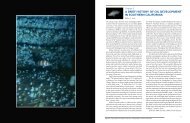checklist (pdf) - The Love Lab - University of California, Santa Barbara
checklist (pdf) - The Love Lab - University of California, Santa Barbara
checklist (pdf) - The Love Lab - University of California, Santa Barbara
Create successful ePaper yourself
Turn your PDF publications into a flip-book with our unique Google optimized e-Paper software.
Seriola lalandi Valenciennes, 1833. Yellowtail, Yellowtail Amberjack, Yellowtail Jack, or Yellowtail Kingfish.<br />
To 250 cm (98.4 in) TL (Robertson and Allen 2002). Circumglobal in warm waters, also in some areas in<br />
temperate waters; in western North Pacific as far north as Japan (Senou in Nakabo 2002) and southern<br />
Kuril Islands (Savinykh 1998); in eastern Pacific from northern British Columbia (54°35'N, 31°00'W;<br />
Nagtegaal and Farlinger 1981) to Chile, including Gulf <strong>of</strong> <strong>California</strong> (Miller and Lea 1972), Islas Galápagos<br />
(Grove and Lavenberg 1997), and Isla Malpelo (Robertson and Allen 2002). Unverified reports from Gulf<br />
<strong>of</strong> Alaska <strong>of</strong>f Kodiak Island and Cordova (Mecklenburg et al. 2002). Primarily epipelagic, recorded from<br />
surface to 300 m (984 ft) (min.: Miller and Lea 1972; max.: <strong>Lab</strong>oute and Grandperrin 2000). Nelson et<br />
al. (2004) changed the <strong>of</strong>ficial common name from Yellowtail to Yellowtail Jack, but West Coast fishers<br />
and researchers may be reluctant to adopt the change. Seriola dorsalis (Gill, 1863) is treated as a junior<br />
synonym. Also recently as S. lalandi dorsalis.<br />
Seriola rivoliana Valenciennes, 1833. Almaco Jack or Pacific Amberjack. To 157 cm (61.8 in) TL in Franke<br />
and Acero (1993), but only to 55 cm (21.6 in) FL in Smith-Vaniz (in Carpenter 2003). Circumglobal;<br />
Korea (Kim et al. 1997) and southern Japan (Senou in Nakabo 2002); Oceanside, southern <strong>California</strong><br />
(Eschmeyer and Herald 1983) to Cabo Blanco, Peru (Chirichigno and Vélez 1998), including Gulf<br />
<strong>of</strong> <strong>California</strong> (Smith-Vaniz in Fischer et al. 1995) and Islas Galápagos (Eschmeyer and Herald 1983).<br />
Pelagic, at depths <strong>of</strong> 3–250 m (10–820 ft; Robertson and Allen 2002).<br />
Trachinotus kennedyi Steindachner, 1876. Blackblotch Pompano or Pacific Permit. To 73 cm (28.7 in) TL<br />
(Robertson and Allen 2002). Bahia San Bartolome (27°41'N, 114°53'W; SIO 60–317), southern Baja<br />
<strong>California</strong> to Pucusana, Peru (Chirichigno and Vélez 1998), including Gulf <strong>of</strong> <strong>California</strong> (Robertson<br />
and Allen 2002). Shallow inshore areas (Watson et al. in Moser 1996) and estuaries (Allen and Robertson<br />
1994) to 72 m (236 ft; Franke and Acero 1993).<br />
Trachinotus paitensis Cuvier, 1832. Paloma Pompano. To 50.8 cm (20 in) TL (Miller and Lea 1972). Redondo<br />
Beach, southern <strong>California</strong> (Miller and Lea 1972) to Chile (Pequeño 1989), including Gulf <strong>of</strong> <strong>California</strong><br />
and Islas Galápagos (Miller and Lea 1972). Shallow inshore areas (Miller and Lea 1972) and to 100 m<br />
(328 ft; Amezcua Linares 1996).<br />
Trachinotus rhodopus Gill, 1863. Gafftopsail Pompano. To 61.0 cm (24 in) TL (Miller and Lea 1972). Zuma<br />
Beach, southern <strong>California</strong> (Miller and Lea 1972) to Callao, Peru (Chirichigno and Vélez 1998), including<br />
southern and central Gulf <strong>of</strong> <strong>California</strong> (Robertson and Allen 2002) and Islas Galápagos (Miller and Lea<br />
1972). Surface to 30 m (98 ft) (min.: Robertson and Allen 2002; max.: Amezcua Linares 1996).<br />
Trachurus symmetricus (Ayres, 1855). Jack Mackerel. To 81.3 cm (32 in) TL (Miller and Lea 1972). Pacific<br />
Ocean south <strong>of</strong> Aleutian Islands (Mecklenburg et al. 2002 [UW 15469]) and in Gulf <strong>of</strong> Alaska to Gulf<br />
<strong>of</strong> <strong>California</strong> (Smith-Vaniz in Fischer et al. 1995). Primarily pelagic, surface (Miller and Lea 1972) from<br />
surf zone (Carlisle et al. 1960) and <strong>of</strong>fshore to 403 m (1,320 ft [220 fm]), sometimes taken in bottom<br />
trawls (Hart 1973). Although Trachurus murphyi Nichols, 1920, found <strong>of</strong>f South America, is considered<br />
by some authors (e.g., Grove and Lavenberg 1997) to be a subspecies <strong>of</strong> T. symmetricus, DNA evidence<br />
indicates it is a separate species (Poulin et al. 2004).<br />
Uraspis helvola (Forster, 1801). Cottonmouth Jack, Whitemouth Jack, or Whitetongue Jack. To 50 cm (19.7 in)<br />
TL (Allen and Roberts 1994). Circumglobal; southern Kuril Islands (Savinykh and Shevtsov 2001) and<br />
southern Japan (Senou in Nakabo 2002); <strong>Santa</strong> Catalina Island, southern <strong>California</strong> (Miller and Lea<br />
1972) to Ecuador (Béarez 1996), including Islas Galápagos (Grove and Lavenberg 1997). Benthopelagic<br />
(Smith-Vaniz in Carpenter and Niem 1999), 10–300 m (33–984 ft; Robertson and Allen 2002). Uraspis<br />
secunda (Poey, 1860) may be a junior synonym (Smith-Vaniz in Carpenter and Niem 1999, Smith-Vaniz<br />
in Carpenter 2003).<br />
119




